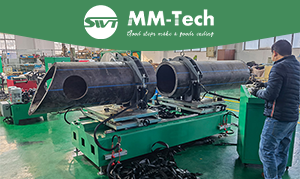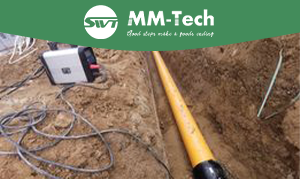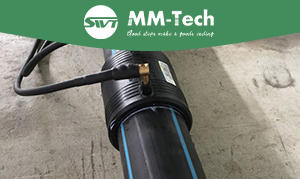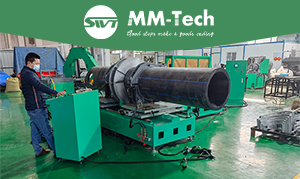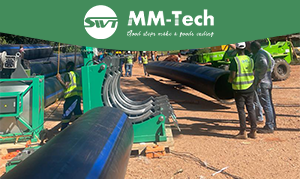Selecting the right electrofusion welding machine plays a vital role in ensuring the success of HDPE pipe projects. Advanced features like real-time monitoring and data logging improve weld precision and safety. Portable designs enhance field usability, while durable machines reduce maintenance needs. MM-Tech offers reliable solutions, combining innovation and quality for lasting results.
Key Takeaways
Pick machines that keep temperature steady (400°F – 450°F) for strong, leak-free connections.
Choose lightweight and easy-to-use machines for tight spaces and simple handling.
Buy good-quality machines to save money over time by lowering repair costs and lasting longer.
Key Features of an Electrofusion Welding Machine
Durability and Build Quality for HDPE Applications
When selecting fusion equipment for joining polyethylene pipes, durability and build quality are critical. Machines designed for HDPE applications must withstand demanding environments while maintaining consistent performance. High-quality materials and reinforced joints ensure long-lasting operation. For example, machines with precise temperature control (400°F – 450°F) and accurate pressure monitoring create strong, leak-proof joints. These features reduce maintenance needs and enhance the reliability of the fusion process.
Key Feature | Importance |
|---|---|
Ensures strong and durable welds by maintaining consistent preheat temperatures (400°F – 450°F). | |
Pressure Control and Monitoring | Essential for creating leak-proof joints; allows for accurate monitoring and adjustment of pressure levels. |
Durability and Build Quality | Machines made with high-quality materials and reinforced joints provide long-lasting performance. |
Compatibility with Electrofusion Fittings and Pipe Sizes
Electrofusion machines must support a wide range of pipe sizes and fittings. This compatibility ensures seamless connections, even when working with diverse pipeline systems. Machines like MM-Tech’s DPS20-3.5KW adapt to various pipe diameters, making them versatile for different projects. Their ability to connect pipes made from different materials further enhances their utility in complex installations.
User-Friendly Interface and Ease of Operation
A user-friendly interface simplifies the fusion process, especially for operators with varying skill levels. Features like high-brightness LCD displays and multilingual support make operation straightforward. Machines that provide detailed output information, such as voltage, current, and remaining welding time, help you monitor progress effectively. This ease of use reduces errors and improves efficiency.
Feature | Impact on HDPE Pipe Joining Performance |
|---|---|
Precise Temperature Control | Ensures strong and durable welds by maintaining consistent heat. |
Automation | Reduces manual errors and increases efficiency in welding. |
Ease of Use | Simplifies operation, making it accessible for various users. |
Durability | Enhances the longevity of the welds and reduces maintenance needs. |
Advanced Safety Features and Certifications
Safety is a top priority in any fusion equipment. Modern machines include advanced safety features like resistance testing and X-ray inspections to ensure flawless welds. Certifications, such as FM approval for firefighting systems, demonstrate their reliability under extreme conditions. For instance, some fittings withstand pressure surges up to 25 bar, proving their durability in critical applications.
Aspect | Details |
|---|---|
Strict measures including resistance testing of every fitting and regular X-ray inspections to ensure flawlessness and high quality. | |
Case Study Performance | AGRU’s electrofusion couplers demonstrated superior performance in an accelerated FNCT test, outperforming other suppliers by a factor of five. |
Extreme Conditions Performance | Electrofusion fittings are FM-approved for firefighting systems, withstanding pressure surges up to 25 bar, proving their reliability in critical applications. |
Portability and Adaptability to Confined Spaces
Portability is essential for field operations, especially in confined spaces. Compact electrofusion machines simplify on-site work, making them ideal for plumbing, construction, and engineering projects. Their ability to connect pipes in tight areas ensures flexibility. For example:
Electrofusion welding works well in challenging environments.
Portable machines adapt to diverse pipeline systems.
Compact designs increase usability in sectors with space constraints.
These machines are widely used in field operations due to their adaptability.
By choosing a machine with these features, you can ensure efficient and reliable HDPE pipe installations.
Cost Factors in Electrofusion Welding Machines
Price Variations Based on Features and Brand
The price of electrofusion welding machines varies significantly depending on their features and brand reputation. Machines with advanced capabilities, such as precise temperature control and real-time monitoring, often cost more but deliver superior performance. For instance, the market for electrofusion welding machines was valued at $1.2 billion in 2022, with a projected growth rate of 6.3% annually through 2030. This growth reflects the increasing demand for efficient fusion equipment in industries like oil and gas, construction, and water management. Understanding these market dynamics helps you evaluate the cost-effectiveness of different machines.
Long-Term Value vs. Initial Cost
Investing in a high-quality electrofusion welding machine may seem costly upfront, but it offers significant long-term value. These machines reduce maintenance expenses and improve the durability of HDPE pipelines. For example:
Electrofusion machines minimize consumable needs, lowering operational costs.
They enable faster welding, reducing labor expenses.
Cost Factor | Impact |
|---|---|
Long-term savings justify higher upfront expenses. |
Additionally, the growing focus on pipeline safety and environmental protection enhances the value of reliable machines. By choosing durable equipment, you ensure a more efficient fusion process and longer-lasting results.
Additional Costs for Accessories and Electrofusion Fittings
Accessories and electrofusion fittings contribute to the overall expense of the fusion process. Fittings vary in cost based on size, material, and brand.
Type of Fitting | Cost Range |
|---|---|
Small Diameter Fittings | Starts at a few dollars |
Large Diameter and Special Fittings | Can cost up to hundreds of dollars |
Material and Brand | Higher quality materials and well-known brands are usually more expensive |
These additional costs can add up, especially for large-scale projects. However, investing in high-quality fittings ensures stronger joints and reduces the risk of leaks during the cooling process. By factoring in these expenses, you can make informed decisions when selecting fusion equipment for joining polyethylene pipes.
Maintenance Tips for Longevity
Regular Cleaning and Inspection of Electrofusion Machines
Regular cleaning and inspection are essential for maintaining the performance of your electrofusion machine. Dirt, moisture, or residue on the machine or pipe surfaces can compromise the fusion process, leading to weak joints. Cleaning the surfaces thoroughly with a suitable cleaning solution reduces joint failure chances by approximately 30%. Inspections help you identify early signs of wear or damage, ensuring high joint reliability. Pay special attention to the heating plate, as contaminants can affect its efficiency. Keeping the fusion zone clean and free from particles ensures durable connections and a long service life.
Proper Storage and Handling for HDPE Welding Equipment
Proper storage and handling practices protect your fusion equipment from damage. Always inspect the equipment upon receipt and report any defects immediately. Store pipes and machines in a cool, dry place, away from heat sources, oils, or flammable materials. Use bands and timbers to handle polyethylene pipes safely. For long-term storage, shield pipes from sunlight with a protective coating. Limit the stacking height to three meters or five pipes to prevent deformation. These measures preserve the equipment’s chemical resistance and ensure it remains ready for use.
Importance of Manufacturer Support and Warranty
Manufacturer support and warranty play a crucial role in maintaining your electrofusion machine. MM-Tech offers a two-year warranty, ensuring reliability and peace of mind. Their support services include troubleshooting, training, and maintenance guidance. Reliable support helps you address issues quickly, reducing downtime and repair costs. A strong warranty also reflects the manufacturer’s confidence in their product, ensuring you receive high-quality fusion equipment designed for long-term use.
Tips for Extending the Lifespan of MM-Tech Electrofusion Machines
To extend the lifespan of your MM-Tech electrofusion machine, follow a consistent maintenance routine. Clean the heating plate regularly to prevent performance issues. Lubricate moving parts to reduce wear and tear. Inspect and tighten electrical connections to avoid malfunctions. Periodically check the cooling process to prevent overheating. Calibrate the control panel to maintain accurate welding parameters. Training operators on proper usage and alignment and clamping techniques ensures optimal performance. With proper care, MM-Tech machines can last over 10 years, delivering high tightness and durability in every weld.
Choosing the right electrofusion welding machine involves evaluating several critical factors. Consider advantages like ease of use in confined spaces and compatibility with various pipe sizes. Ensure the machine supports HDPE pipes and maintains joint integrity under pressure. Assess your specific needs, including pipe joining applications, budget, and environmental conditions.
MM-Tech offers high-quality electrofusion welding machines designed for reliability and efficiency. Their machines comply with international standards and operate across a wide temperature range, making them ideal for diverse projects. By selecting MM-Tech, you ensure durable and precise pipe joining solutions.
Key Factor | Description |
|---|---|
Advantages | Connections can be made without external heat sources, suitable for small or isolated areas. |
Compatibility | Can connect different diameter pipes and is suitable for modern automated devices. |
Joint Integrity | Joints maintain the same pressure ratings as the enclosing pipeline, ensuring system integrity. |
Influencing Factors | Ambient temperature, cleanliness of pipe surfaces, correct fusion time and voltage are crucial. |
FAQ
What is the ideal temperature range for electrofusion welding?
The ideal temperature range for electrofusion welding typically falls between 400°F and 450°F. This ensures strong, durable joints for HDPE pipes.
How do you ensure a clean fusion process?
Use a suitable cleaning solution to remove dirt and moisture from pipe surfaces. This reduces joint failure risks by approximately 30%.
Tip: Always inspect the heating plate for contaminants before starting the welding process.
Can MM-Tech machines handle different pipe sizes?
Yes, MM-Tech machines, like the DPS20-3.5KW, adapt to various pipe diameters. This versatility makes them suitable for diverse HDPE pipe projects.


